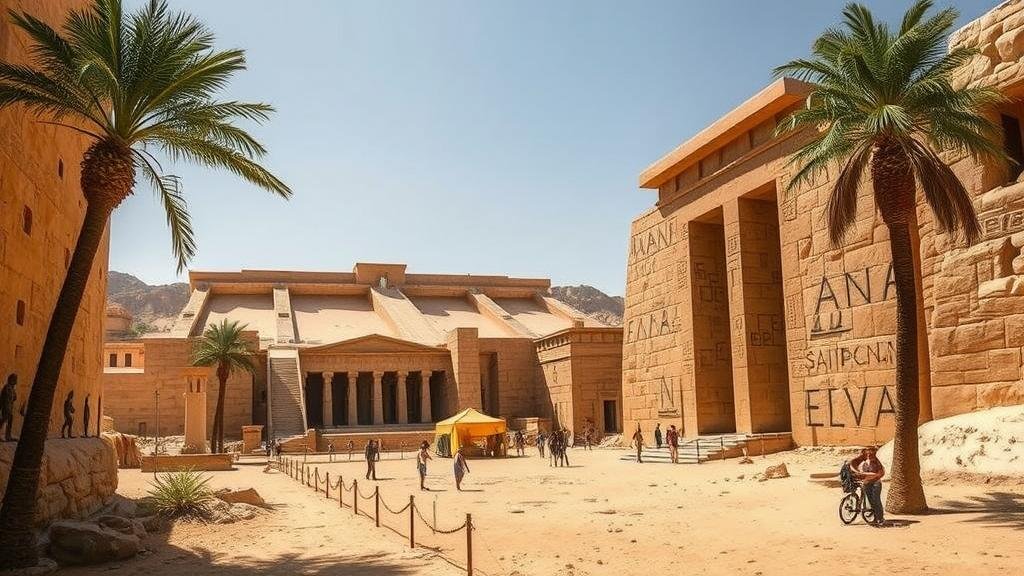Investigating the rumored site of Akhetaten, Pharaoh Akhenaten’s city in Egypt.
Investigating the Rumored Site of Akhetaten
Akhetaten, the ancient city founded by Pharaoh Akhenaten around 1346 BCE, remains one of Egypts most intriguing historical locations. Its brief but significant existence plays a crucial role in our understanding of the evolution of ancient Egyptian civilization, particularly during the 18th Dynasty. The city is often associated with the radical religious shifts initiated by Akhenaten, who is best known for promoting the worship of the sun disk, Aten, as the sole god.
Historical Context
Located in modern-day Amarna, Egypt, Akhetaten was established as the new capital during Akhenaten’s reign. creation of this city was not just an urban development but also a profound cultural shift in Egyptian society. By moving the capital from Thebes to Akhetaten, Akhenaten aimed to diminish the power of the established priesthood and promote his religious views centered around Aten.
The city was rapidly constructed, showcasing an unprecedented architectural style that contrasted sharply with previous settlements in Egypt. It included vast temples, impressive palaces, and residential areas that accommodated the elite and artisans who served Akhenaten’s vision.
Geographical Location
Akhetaten is located in a stretch of desert land by the Nile River, primarily situated between the modern cities of Minya and Beni Suef. site is characterized by its unique landscapes, with cliffs that rise sharply alongside the river valley. This strategic positioning allowed both access and a measure of protection, vital for a newly established capital.
Archaeological Discoveries
The site of Akhetaten has been a focal point for archaeologists since its rediscovery in the late 19th century. One of the most prominent figures in its excavation was Sir Alan Gardiner, who conducted significant studies between 1891 and 1892. Subsequent excavations have revealed:
- Royal Temples: The Great Aten Temple, which functioned as the primary religious site dedicated to Aten, featured vast open courts topped with extensive alabaster and limestone carvings.
- Residential Areas: Houses built for the royal family and elite showed evidence of advanced domestic architecture, including numerous rooms, courts, and gardens.
- Artistic Depictions: Unique artistic styles emerged that depicted the royal family in intimate and informal settings, signaling a departure from previous artistic conventions.
The Significance of Akhetaten
Akhetaten is often viewed as a radical departure from conventional Egyptian society. It brought forth significant changes in religious practice, art, and social structure. With the establishment of Atenism, Akhenaten initiated a form of monotheism that was unprecedented in ancient Egypt, prompting debates among historians about its impact on subsequent religious developments.
Plus, the city served as a reflection of Akhenatens controversial reign. After his death, traditional religious practices were restored, leading to the citys eventual decline and abandonment. It is a compelling example of how power dynamics can shift cultural and religious landscapes.
Modern Investigations and Challenges
Investigations into Akhetaten continue into the present day. Modern archaeological techniques, including aerial photography and satellite imagery, have enhanced researchers’ ability to map the city and uncover additional layers of history. But, these efforts face challenges such as:
- Environmental Factors: The harsh desert climate threatens preservation, with sandstorms and temperature fluctuations potentially damaging artifacts.
- Access and Funding: Limited resources for archaeological projects can hinder extensive excavations and studies.
Conclusion and Future Directions
Investigating Akhetaten provides invaluable insights into a transformative period in ancient Egyptian history. The city stands as a testament to Akhenaten’s complex legacy, encapsulating the intersection of power, religion, and art. As archaeologists continue to unravel its mysteries, Akhetaten will undoubtedly remain a critical focal point for understanding the dynamics of one of historys most fascinating civilizations.
To wrap up, as interest in ancient civilizations continues to grow, Akhetaten’s archaeological significance offers abundant opportunities for educational outreach and scholarly discourse, ensuring its place in both academia and popular culture.



